Managerial Accounting Case Study: Costing Methods Comparison
VerifiedAdded on 2023/01/18
|15
|1931
|90
Project
AI Summary
This report analyzes a managerial accounting case study involving Harvard Square Inc., a manufacturing company with traditional and modern product lines. The report compares traditional costing and activity-based costing (ABC) methods, detailing the allocation of overhead costs using machine hour rates and various cost drivers, respectively. It examines the impact of these costing systems on product profitability, highlighting how ABC provides a more accurate cost structure by assigning costs based on activities. Furthermore, the report incorporates regression analysis to determine fixed and variable costs for different clients, illustrating how cost behavior varies based on product specifications. The analysis covers the calculation of gross profit margins, the influence of different costing methods on product profitability, and the implications for cost control and management decision-making. The case study emphasizes the importance of choosing the appropriate costing system for accurate product costing and effective cost management, supported by references to relevant academic literature.
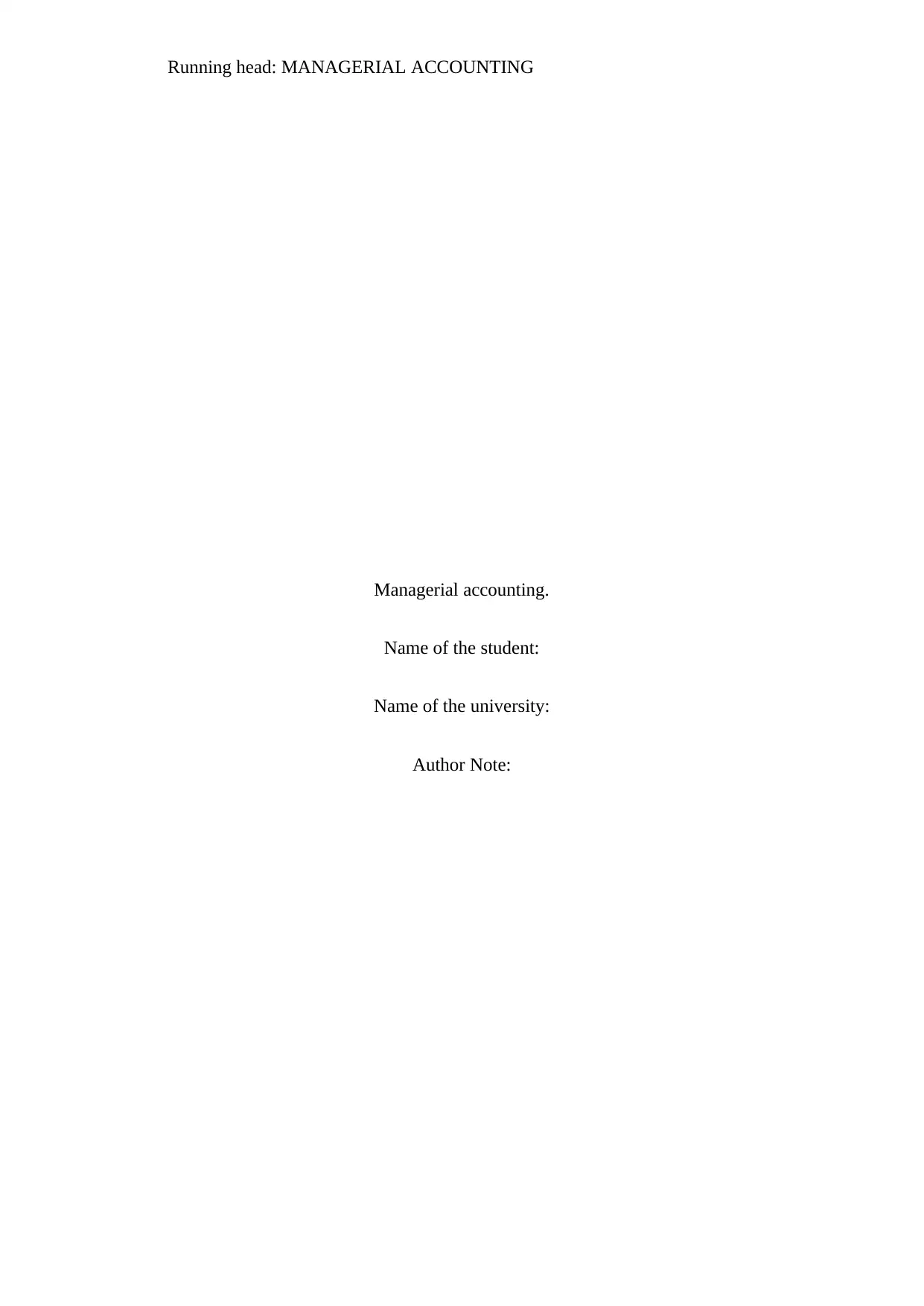
Running head: MANAGERIAL ACCOUNTING
Managerial accounting.
Name of the student:
Name of the university:
Author Note:
Managerial accounting.
Name of the student:
Name of the university:
Author Note:
Paraphrase This Document
Need a fresh take? Get an instant paraphrase of this document with our AI Paraphraser
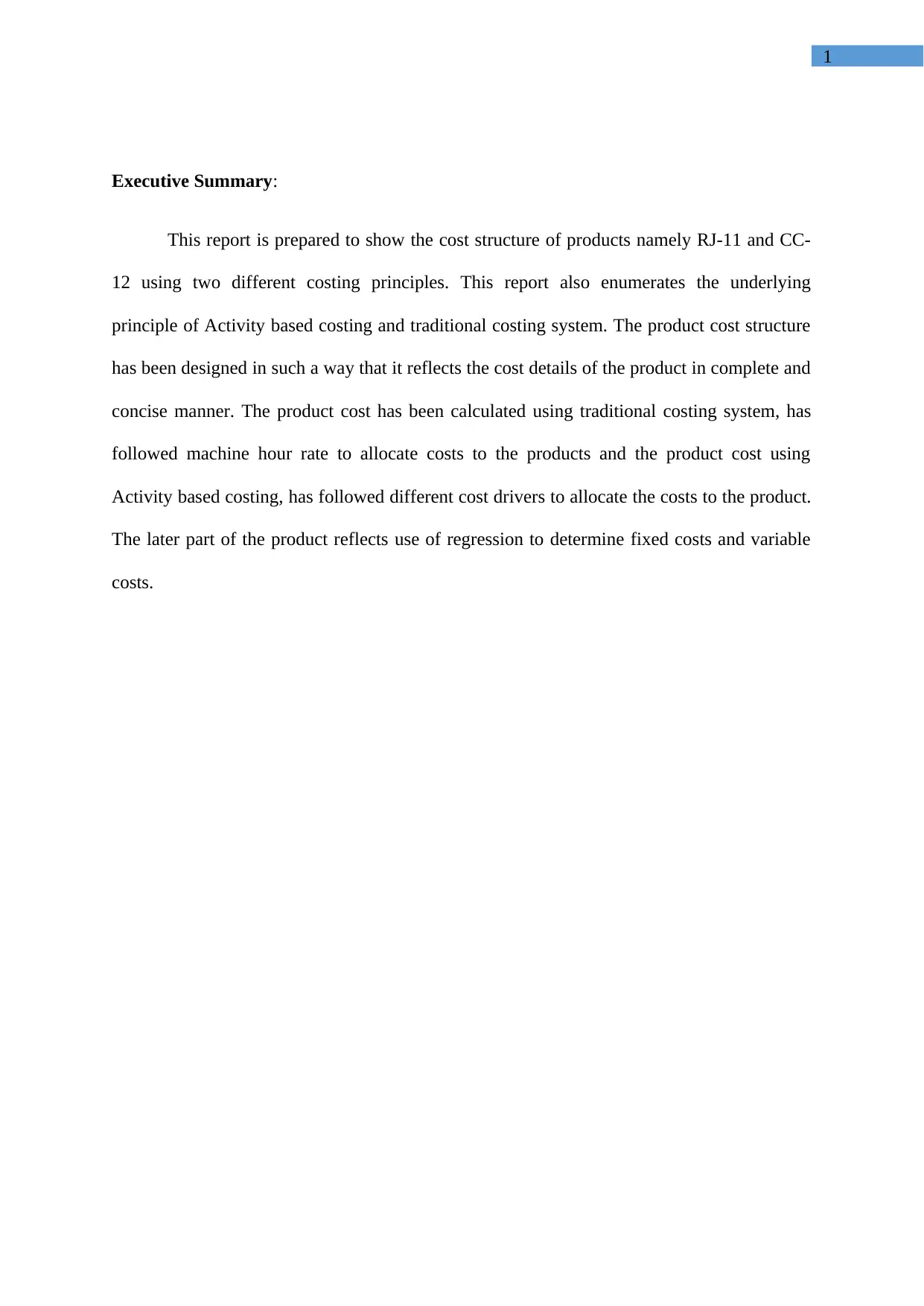
1
Executive Summary:
This report is prepared to show the cost structure of products namely RJ-11 and CC-
12 using two different costing principles. This report also enumerates the underlying
principle of Activity based costing and traditional costing system. The product cost structure
has been designed in such a way that it reflects the cost details of the product in complete and
concise manner. The product cost has been calculated using traditional costing system, has
followed machine hour rate to allocate costs to the products and the product cost using
Activity based costing, has followed different cost drivers to allocate the costs to the product.
The later part of the product reflects use of regression to determine fixed costs and variable
costs.
Executive Summary:
This report is prepared to show the cost structure of products namely RJ-11 and CC-
12 using two different costing principles. This report also enumerates the underlying
principle of Activity based costing and traditional costing system. The product cost structure
has been designed in such a way that it reflects the cost details of the product in complete and
concise manner. The product cost has been calculated using traditional costing system, has
followed machine hour rate to allocate costs to the products and the product cost using
Activity based costing, has followed different cost drivers to allocate the costs to the product.
The later part of the product reflects use of regression to determine fixed costs and variable
costs.
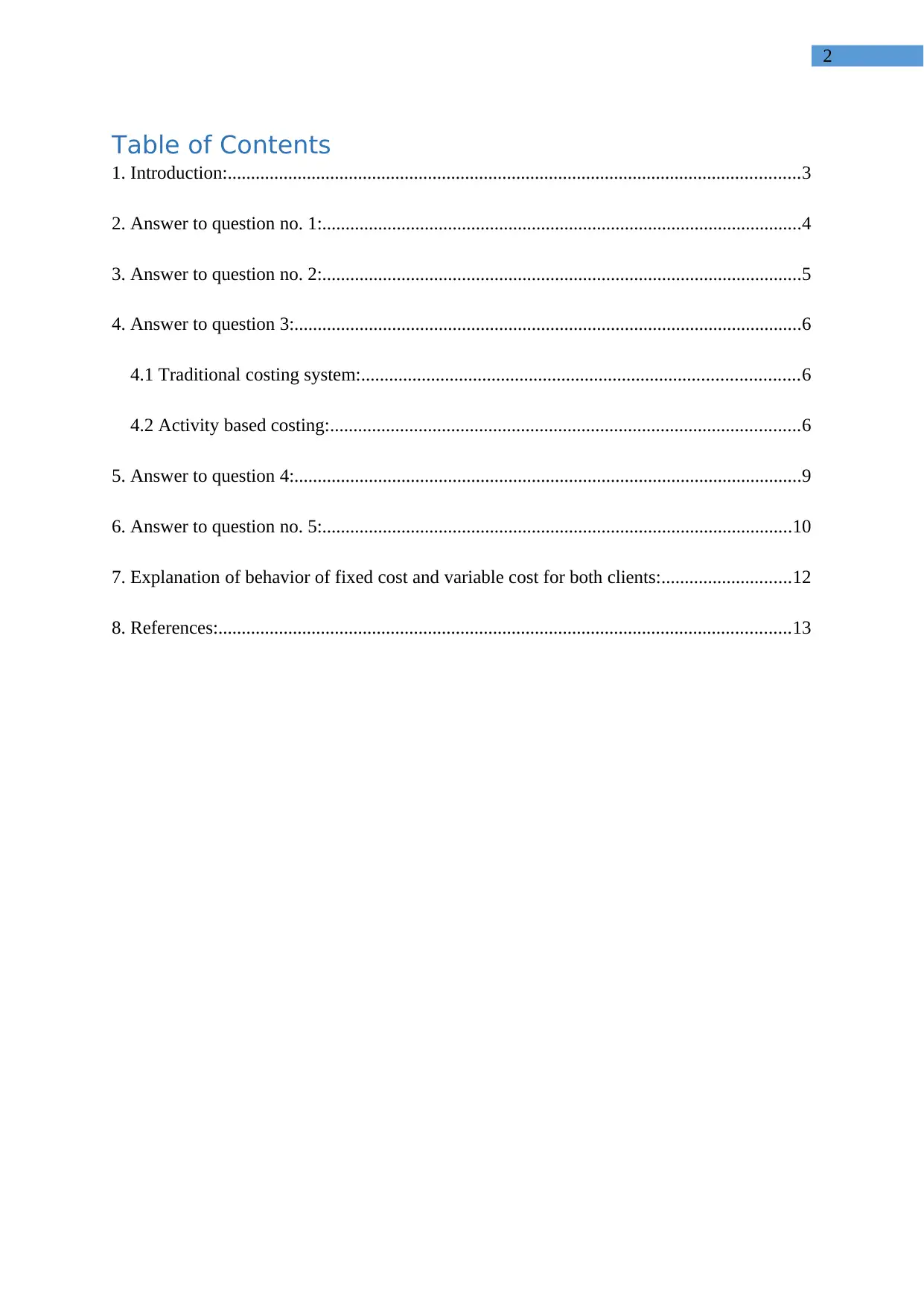
2
Table of Contents
1. Introduction:...........................................................................................................................3
2. Answer to question no. 1:.......................................................................................................4
3. Answer to question no. 2:.......................................................................................................5
4. Answer to question 3:.............................................................................................................6
4.1 Traditional costing system:..............................................................................................6
4.2 Activity based costing:.....................................................................................................6
5. Answer to question 4:.............................................................................................................9
6. Answer to question no. 5:.....................................................................................................10
7. Explanation of behavior of fixed cost and variable cost for both clients:............................12
8. References:...........................................................................................................................13
Table of Contents
1. Introduction:...........................................................................................................................3
2. Answer to question no. 1:.......................................................................................................4
3. Answer to question no. 2:.......................................................................................................5
4. Answer to question 3:.............................................................................................................6
4.1 Traditional costing system:..............................................................................................6
4.2 Activity based costing:.....................................................................................................6
5. Answer to question 4:.............................................................................................................9
6. Answer to question no. 5:.....................................................................................................10
7. Explanation of behavior of fixed cost and variable cost for both clients:............................12
8. References:...........................................................................................................................13
⊘ This is a preview!⊘
Do you want full access?
Subscribe today to unlock all pages.

Trusted by 1+ million students worldwide
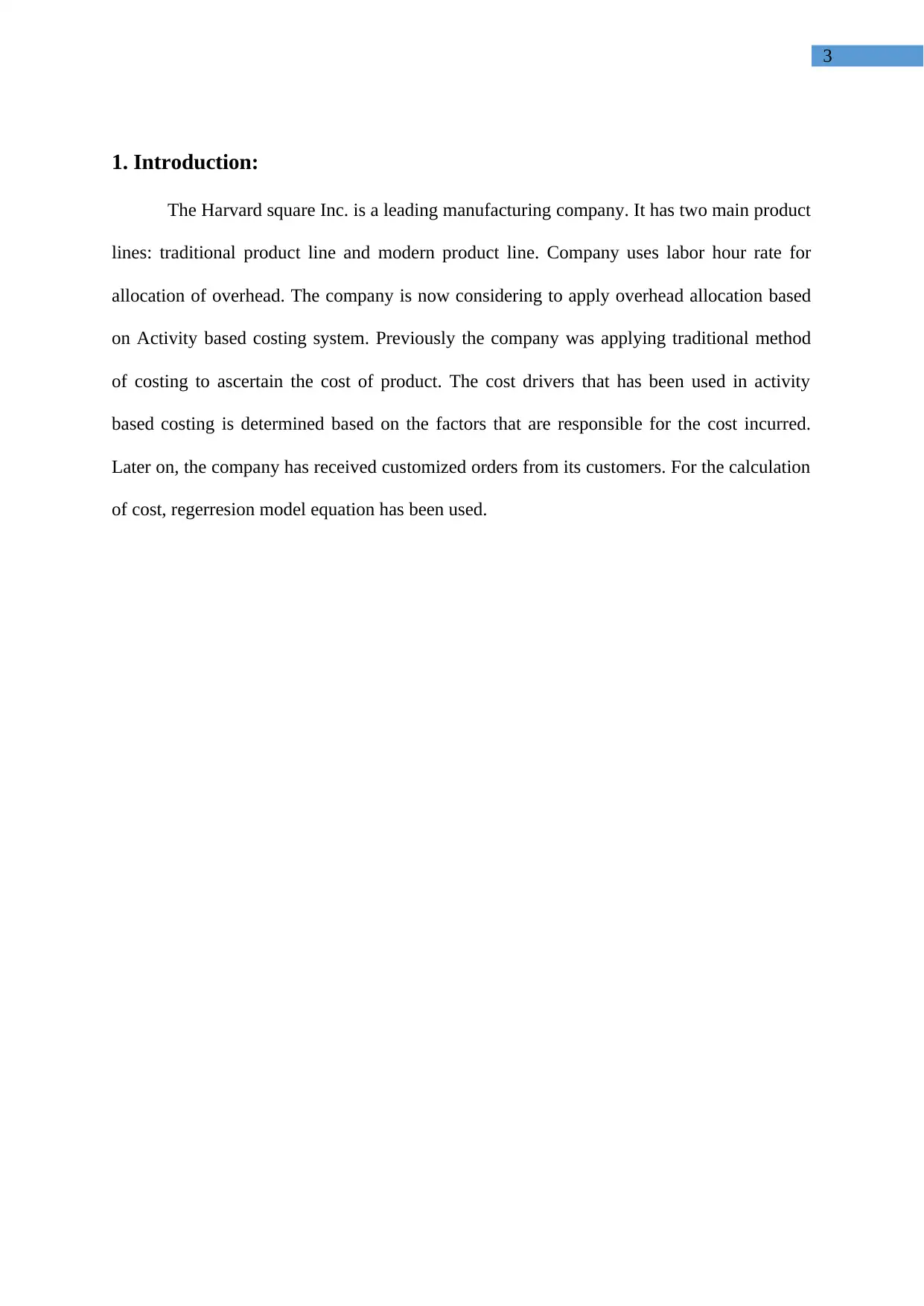
3
1. Introduction:
The Harvard square Inc. is a leading manufacturing company. It has two main product
lines: traditional product line and modern product line. Company uses labor hour rate for
allocation of overhead. The company is now considering to apply overhead allocation based
on Activity based costing system. Previously the company was applying traditional method
of costing to ascertain the cost of product. The cost drivers that has been used in activity
based costing is determined based on the factors that are responsible for the cost incurred.
Later on, the company has received customized orders from its customers. For the calculation
of cost, regerresion model equation has been used.
1. Introduction:
The Harvard square Inc. is a leading manufacturing company. It has two main product
lines: traditional product line and modern product line. Company uses labor hour rate for
allocation of overhead. The company is now considering to apply overhead allocation based
on Activity based costing system. Previously the company was applying traditional method
of costing to ascertain the cost of product. The cost drivers that has been used in activity
based costing is determined based on the factors that are responsible for the cost incurred.
Later on, the company has received customized orders from its customers. For the calculation
of cost, regerresion model equation has been used.
Paraphrase This Document
Need a fresh take? Get an instant paraphrase of this document with our AI Paraphraser
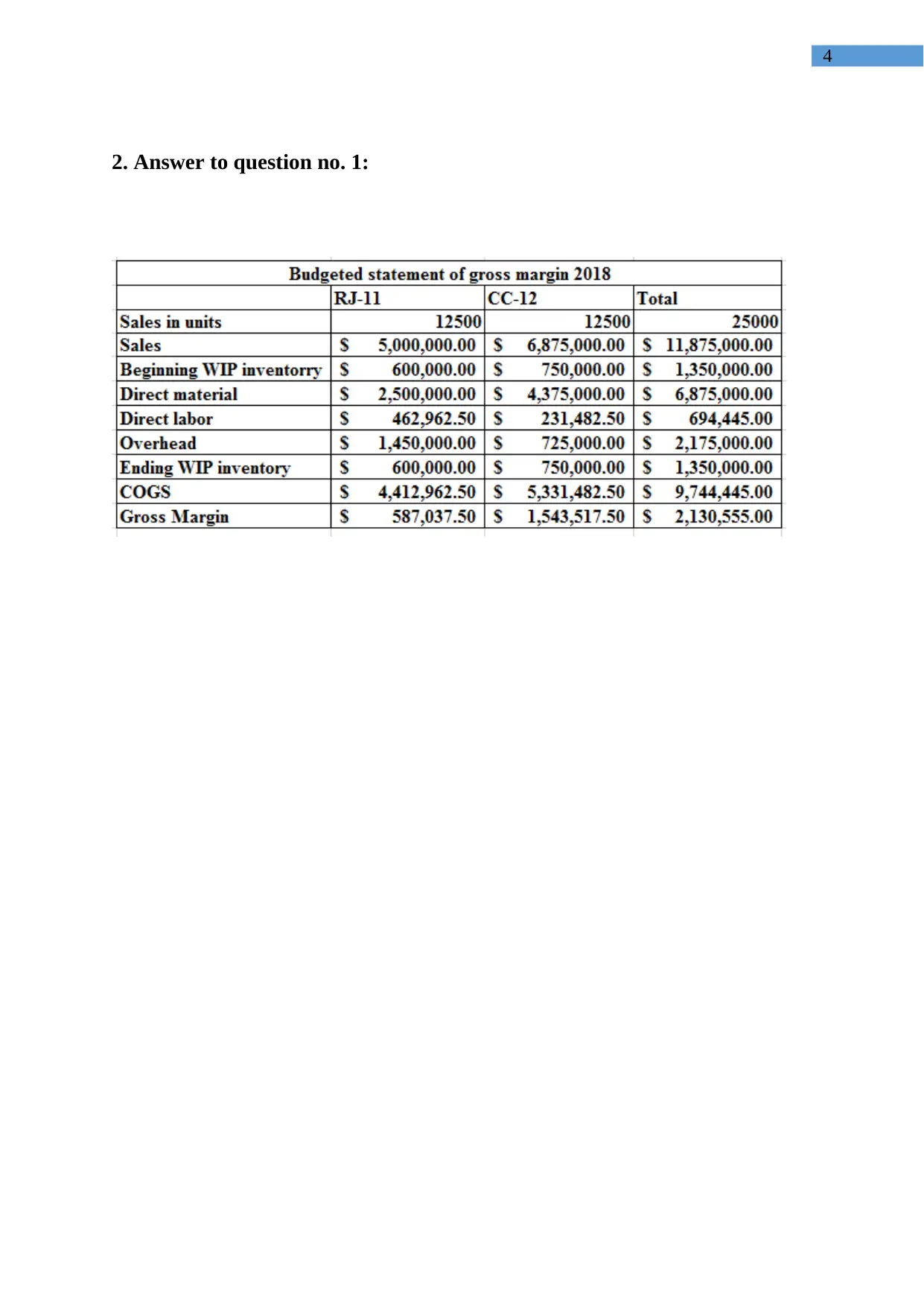
4
2. Answer to question no. 1:
2. Answer to question no. 1:
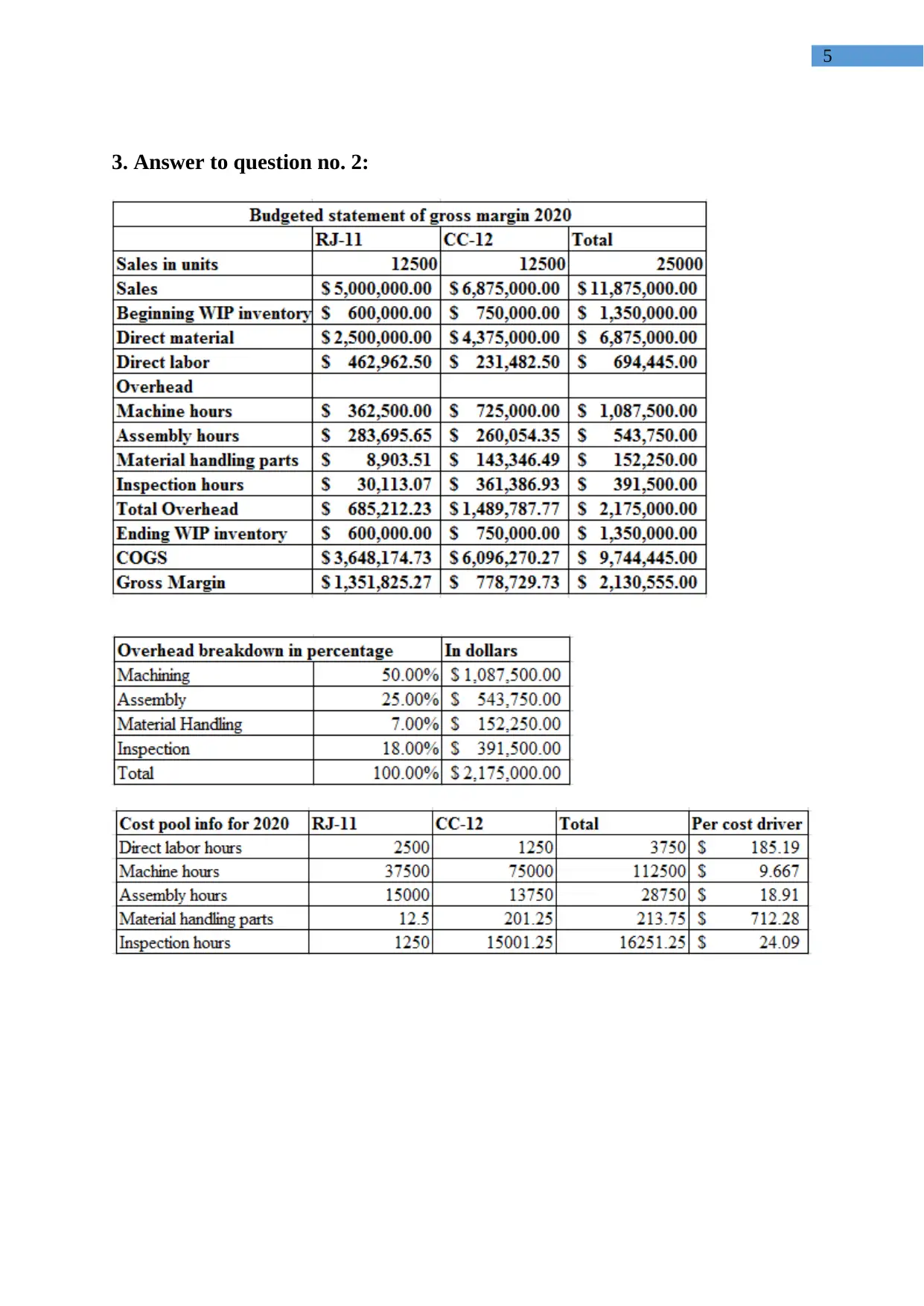
5
3. Answer to question no. 2:
3. Answer to question no. 2:
⊘ This is a preview!⊘
Do you want full access?
Subscribe today to unlock all pages.

Trusted by 1+ million students worldwide
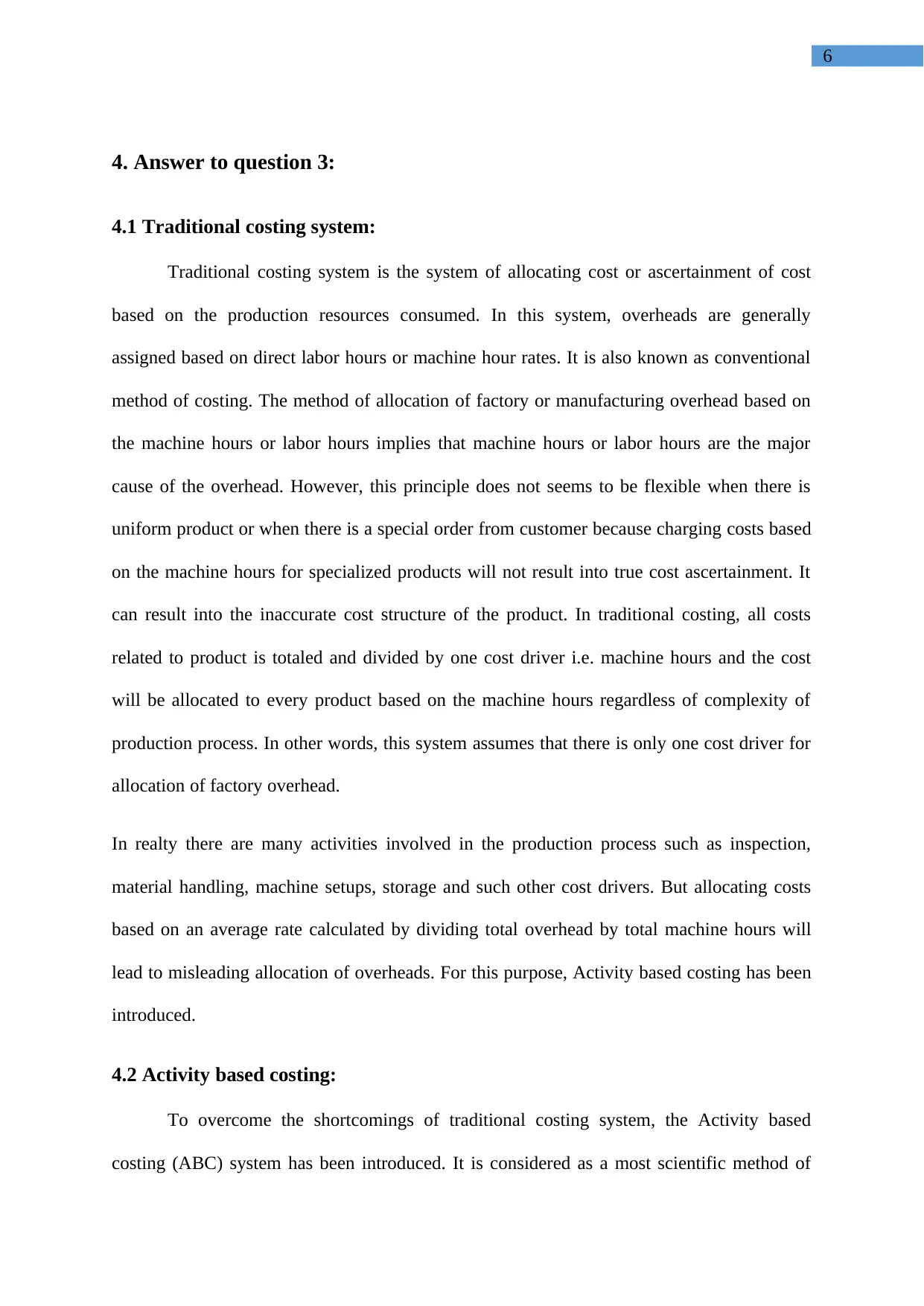
6
4. Answer to question 3:
4.1 Traditional costing system:
Traditional costing system is the system of allocating cost or ascertainment of cost
based on the production resources consumed. In this system, overheads are generally
assigned based on direct labor hours or machine hour rates. It is also known as conventional
method of costing. The method of allocation of factory or manufacturing overhead based on
the machine hours or labor hours implies that machine hours or labor hours are the major
cause of the overhead. However, this principle does not seems to be flexible when there is
uniform product or when there is a special order from customer because charging costs based
on the machine hours for specialized products will not result into true cost ascertainment. It
can result into the inaccurate cost structure of the product. In traditional costing, all costs
related to product is totaled and divided by one cost driver i.e. machine hours and the cost
will be allocated to every product based on the machine hours regardless of complexity of
production process. In other words, this system assumes that there is only one cost driver for
allocation of factory overhead.
In realty there are many activities involved in the production process such as inspection,
material handling, machine setups, storage and such other cost drivers. But allocating costs
based on an average rate calculated by dividing total overhead by total machine hours will
lead to misleading allocation of overheads. For this purpose, Activity based costing has been
introduced.
4.2 Activity based costing:
To overcome the shortcomings of traditional costing system, the Activity based
costing (ABC) system has been introduced. It is considered as a most scientific method of
4. Answer to question 3:
4.1 Traditional costing system:
Traditional costing system is the system of allocating cost or ascertainment of cost
based on the production resources consumed. In this system, overheads are generally
assigned based on direct labor hours or machine hour rates. It is also known as conventional
method of costing. The method of allocation of factory or manufacturing overhead based on
the machine hours or labor hours implies that machine hours or labor hours are the major
cause of the overhead. However, this principle does not seems to be flexible when there is
uniform product or when there is a special order from customer because charging costs based
on the machine hours for specialized products will not result into true cost ascertainment. It
can result into the inaccurate cost structure of the product. In traditional costing, all costs
related to product is totaled and divided by one cost driver i.e. machine hours and the cost
will be allocated to every product based on the machine hours regardless of complexity of
production process. In other words, this system assumes that there is only one cost driver for
allocation of factory overhead.
In realty there are many activities involved in the production process such as inspection,
material handling, machine setups, storage and such other cost drivers. But allocating costs
based on an average rate calculated by dividing total overhead by total machine hours will
lead to misleading allocation of overheads. For this purpose, Activity based costing has been
introduced.
4.2 Activity based costing:
To overcome the shortcomings of traditional costing system, the Activity based
costing (ABC) system has been introduced. It is considered as a most scientific method of
Paraphrase This Document
Need a fresh take? Get an instant paraphrase of this document with our AI Paraphraser
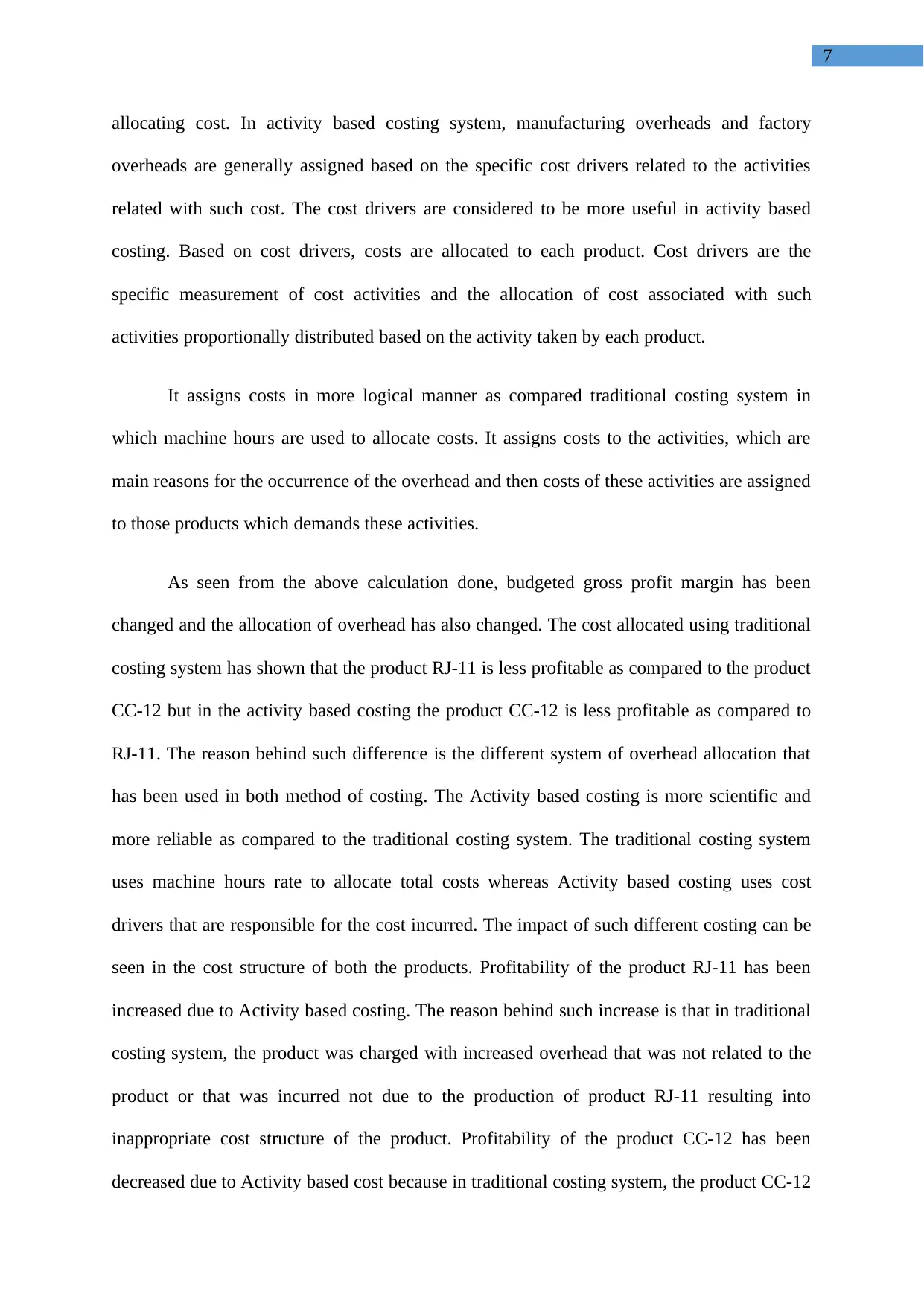
7
allocating cost. In activity based costing system, manufacturing overheads and factory
overheads are generally assigned based on the specific cost drivers related to the activities
related with such cost. The cost drivers are considered to be more useful in activity based
costing. Based on cost drivers, costs are allocated to each product. Cost drivers are the
specific measurement of cost activities and the allocation of cost associated with such
activities proportionally distributed based on the activity taken by each product.
It assigns costs in more logical manner as compared traditional costing system in
which machine hours are used to allocate costs. It assigns costs to the activities, which are
main reasons for the occurrence of the overhead and then costs of these activities are assigned
to those products which demands these activities.
As seen from the above calculation done, budgeted gross profit margin has been
changed and the allocation of overhead has also changed. The cost allocated using traditional
costing system has shown that the product RJ-11 is less profitable as compared to the product
CC-12 but in the activity based costing the product CC-12 is less profitable as compared to
RJ-11. The reason behind such difference is the different system of overhead allocation that
has been used in both method of costing. The Activity based costing is more scientific and
more reliable as compared to the traditional costing system. The traditional costing system
uses machine hours rate to allocate total costs whereas Activity based costing uses cost
drivers that are responsible for the cost incurred. The impact of such different costing can be
seen in the cost structure of both the products. Profitability of the product RJ-11 has been
increased due to Activity based costing. The reason behind such increase is that in traditional
costing system, the product was charged with increased overhead that was not related to the
product or that was incurred not due to the production of product RJ-11 resulting into
inappropriate cost structure of the product. Profitability of the product CC-12 has been
decreased due to Activity based cost because in traditional costing system, the product CC-12
allocating cost. In activity based costing system, manufacturing overheads and factory
overheads are generally assigned based on the specific cost drivers related to the activities
related with such cost. The cost drivers are considered to be more useful in activity based
costing. Based on cost drivers, costs are allocated to each product. Cost drivers are the
specific measurement of cost activities and the allocation of cost associated with such
activities proportionally distributed based on the activity taken by each product.
It assigns costs in more logical manner as compared traditional costing system in
which machine hours are used to allocate costs. It assigns costs to the activities, which are
main reasons for the occurrence of the overhead and then costs of these activities are assigned
to those products which demands these activities.
As seen from the above calculation done, budgeted gross profit margin has been
changed and the allocation of overhead has also changed. The cost allocated using traditional
costing system has shown that the product RJ-11 is less profitable as compared to the product
CC-12 but in the activity based costing the product CC-12 is less profitable as compared to
RJ-11. The reason behind such difference is the different system of overhead allocation that
has been used in both method of costing. The Activity based costing is more scientific and
more reliable as compared to the traditional costing system. The traditional costing system
uses machine hours rate to allocate total costs whereas Activity based costing uses cost
drivers that are responsible for the cost incurred. The impact of such different costing can be
seen in the cost structure of both the products. Profitability of the product RJ-11 has been
increased due to Activity based costing. The reason behind such increase is that in traditional
costing system, the product was charged with increased overhead that was not related to the
product or that was incurred not due to the production of product RJ-11 resulting into
inappropriate cost structure of the product. Profitability of the product CC-12 has been
decreased due to Activity based cost because in traditional costing system, the product CC-12
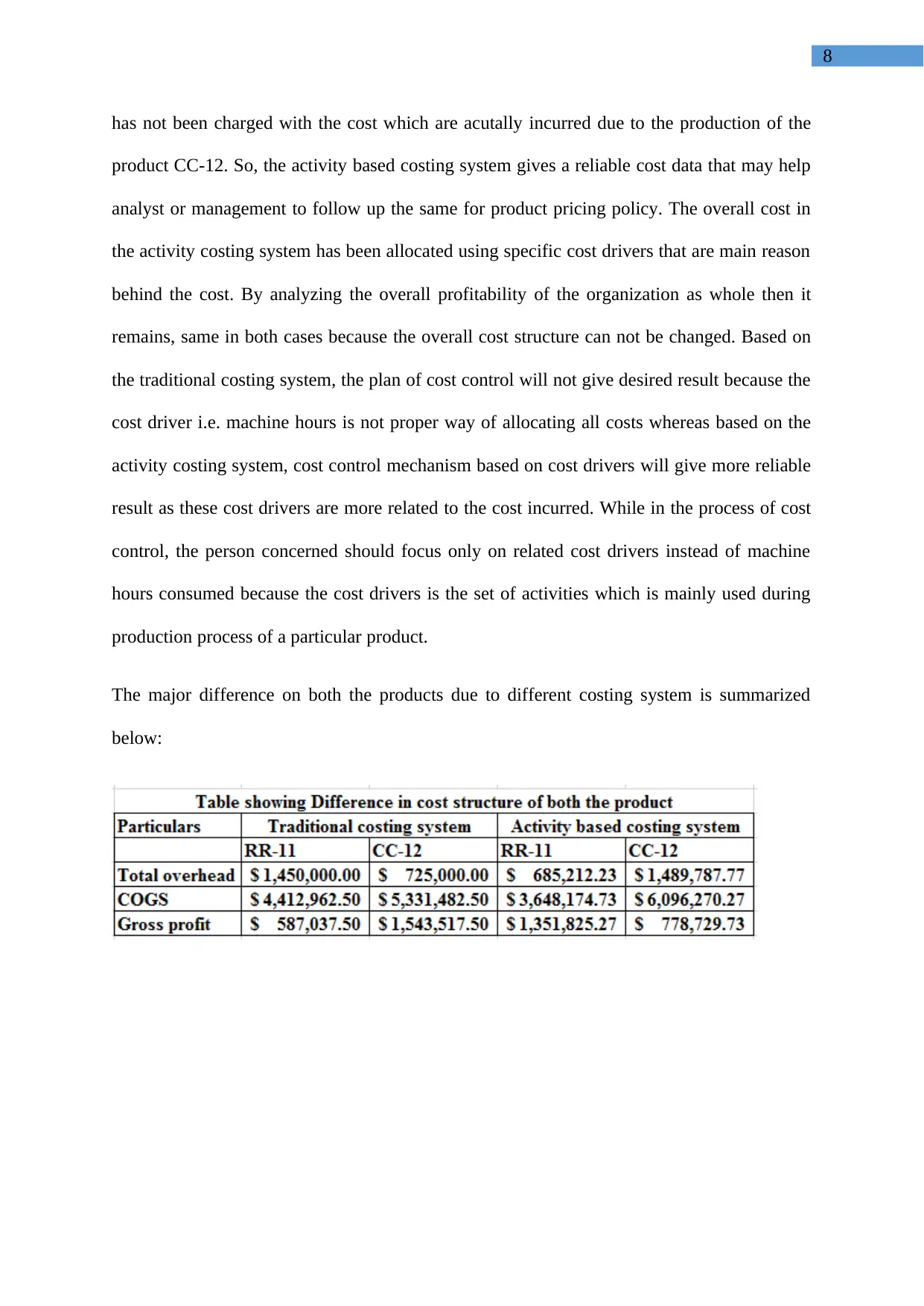
8
has not been charged with the cost which are acutally incurred due to the production of the
product CC-12. So, the activity based costing system gives a reliable cost data that may help
analyst or management to follow up the same for product pricing policy. The overall cost in
the activity costing system has been allocated using specific cost drivers that are main reason
behind the cost. By analyzing the overall profitability of the organization as whole then it
remains, same in both cases because the overall cost structure can not be changed. Based on
the traditional costing system, the plan of cost control will not give desired result because the
cost driver i.e. machine hours is not proper way of allocating all costs whereas based on the
activity costing system, cost control mechanism based on cost drivers will give more reliable
result as these cost drivers are more related to the cost incurred. While in the process of cost
control, the person concerned should focus only on related cost drivers instead of machine
hours consumed because the cost drivers is the set of activities which is mainly used during
production process of a particular product.
The major difference on both the products due to different costing system is summarized
below:
has not been charged with the cost which are acutally incurred due to the production of the
product CC-12. So, the activity based costing system gives a reliable cost data that may help
analyst or management to follow up the same for product pricing policy. The overall cost in
the activity costing system has been allocated using specific cost drivers that are main reason
behind the cost. By analyzing the overall profitability of the organization as whole then it
remains, same in both cases because the overall cost structure can not be changed. Based on
the traditional costing system, the plan of cost control will not give desired result because the
cost driver i.e. machine hours is not proper way of allocating all costs whereas based on the
activity costing system, cost control mechanism based on cost drivers will give more reliable
result as these cost drivers are more related to the cost incurred. While in the process of cost
control, the person concerned should focus only on related cost drivers instead of machine
hours consumed because the cost drivers is the set of activities which is mainly used during
production process of a particular product.
The major difference on both the products due to different costing system is summarized
below:
⊘ This is a preview!⊘
Do you want full access?
Subscribe today to unlock all pages.

Trusted by 1+ million students worldwide
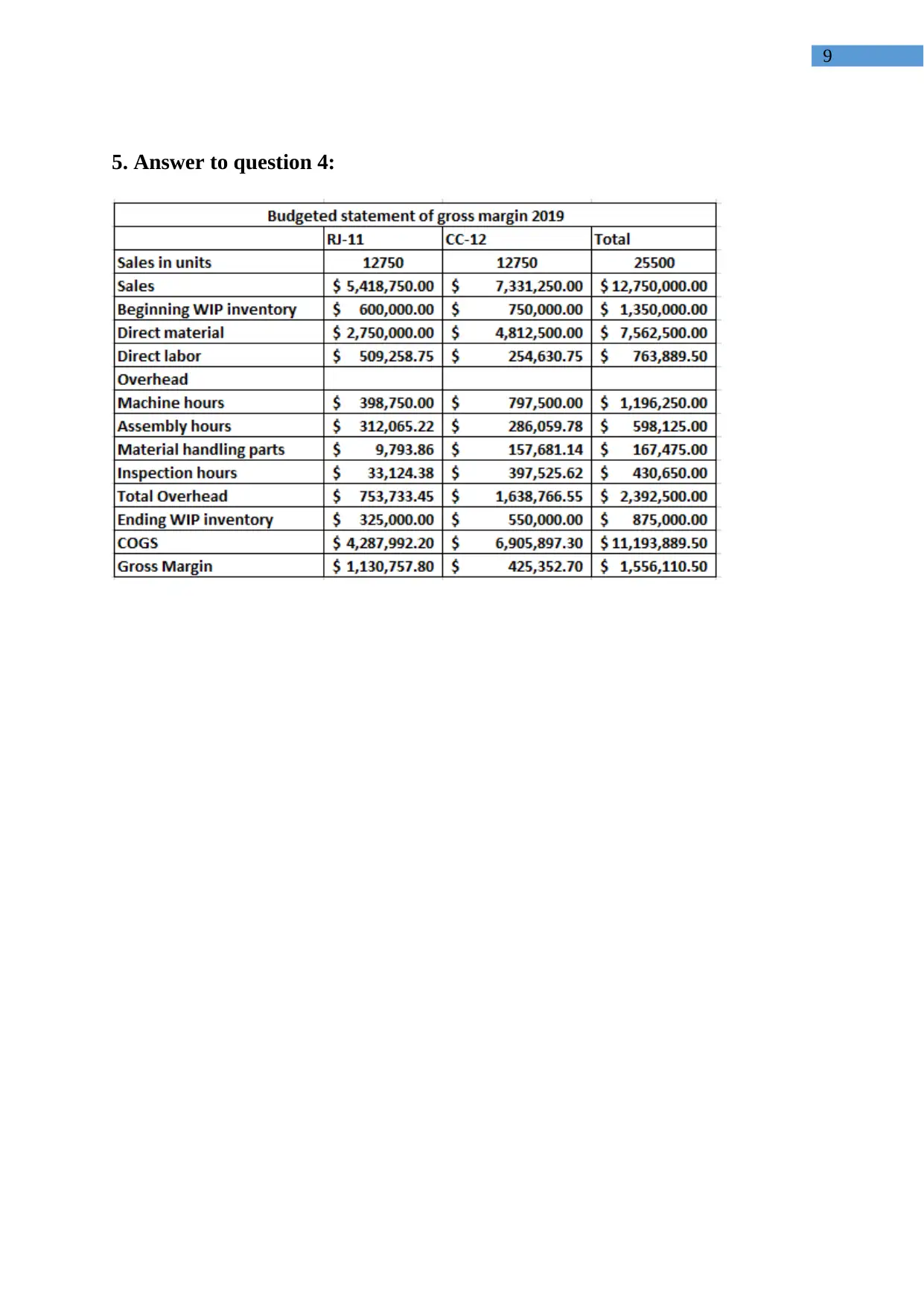
9
5. Answer to question 4:
5. Answer to question 4:
Paraphrase This Document
Need a fresh take? Get an instant paraphrase of this document with our AI Paraphraser
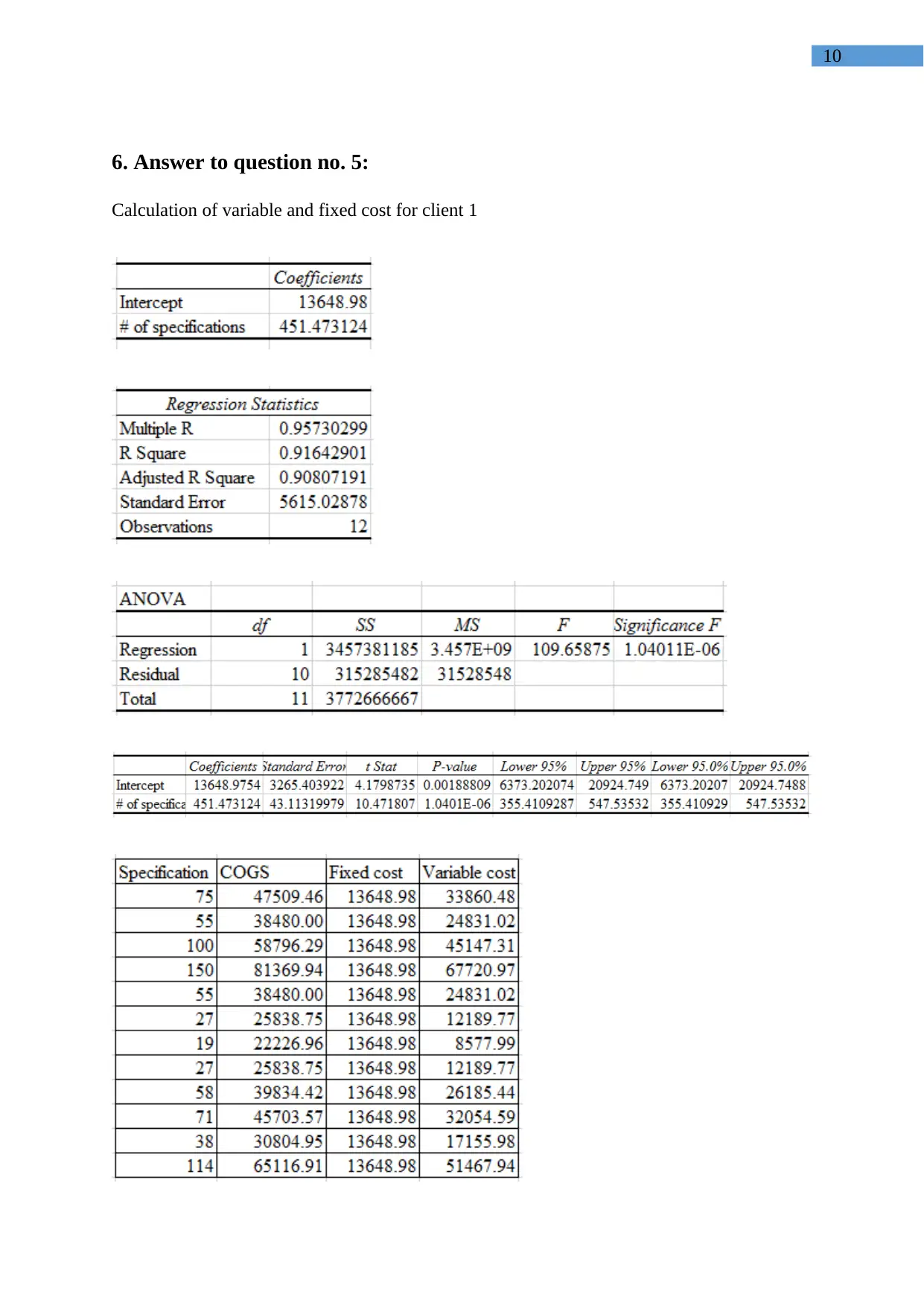
10
6. Answer to question no. 5:
Calculation of variable and fixed cost for client 1
6. Answer to question no. 5:
Calculation of variable and fixed cost for client 1
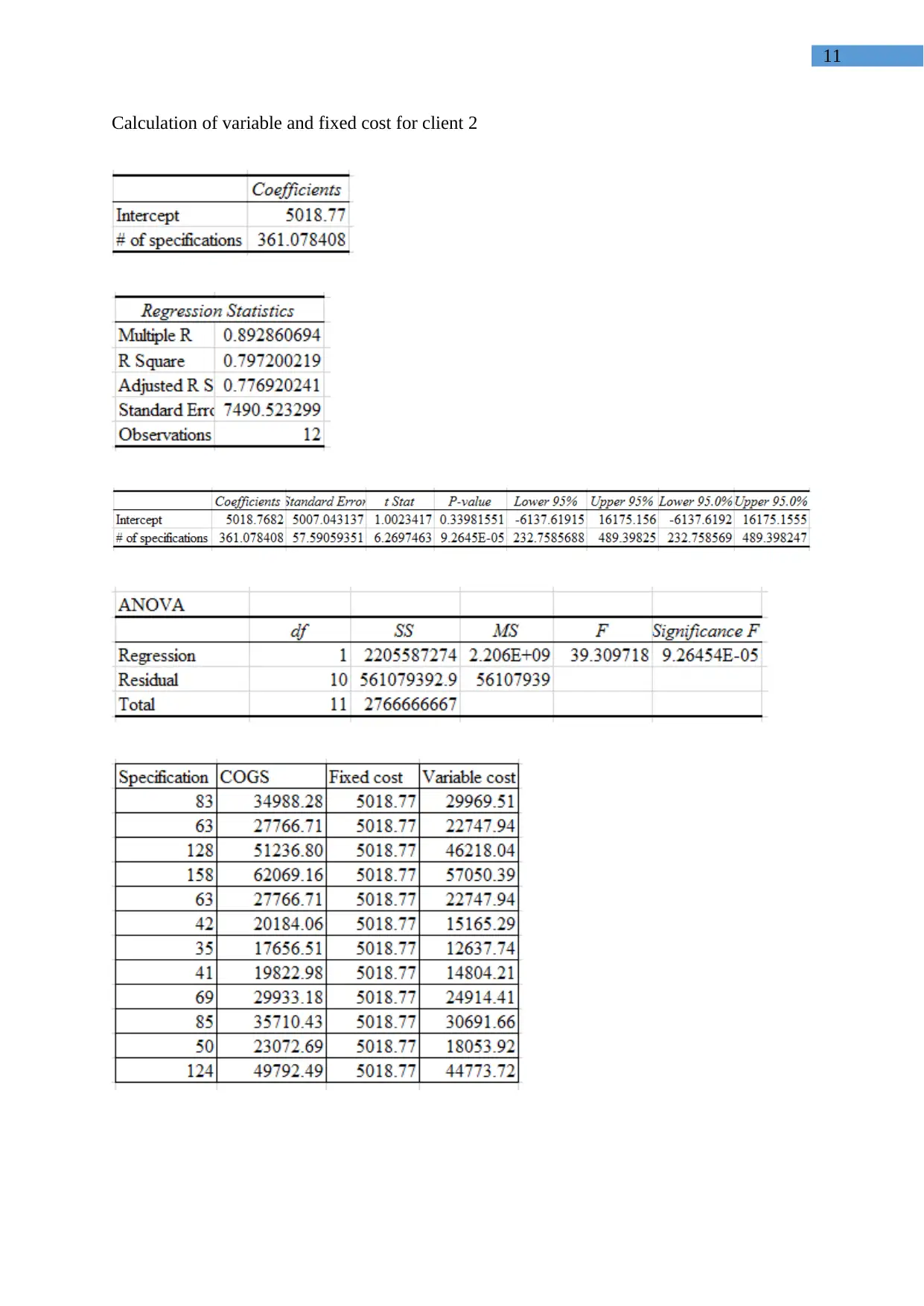
11
Calculation of variable and fixed cost for client 2
Calculation of variable and fixed cost for client 2
⊘ This is a preview!⊘
Do you want full access?
Subscribe today to unlock all pages.

Trusted by 1+ million students worldwide
1 out of 15
Related Documents
Your All-in-One AI-Powered Toolkit for Academic Success.
+13062052269
info@desklib.com
Available 24*7 on WhatsApp / Email
![[object Object]](/_next/static/media/star-bottom.7253800d.svg)
Unlock your academic potential
Copyright © 2020–2025 A2Z Services. All Rights Reserved. Developed and managed by ZUCOL.




